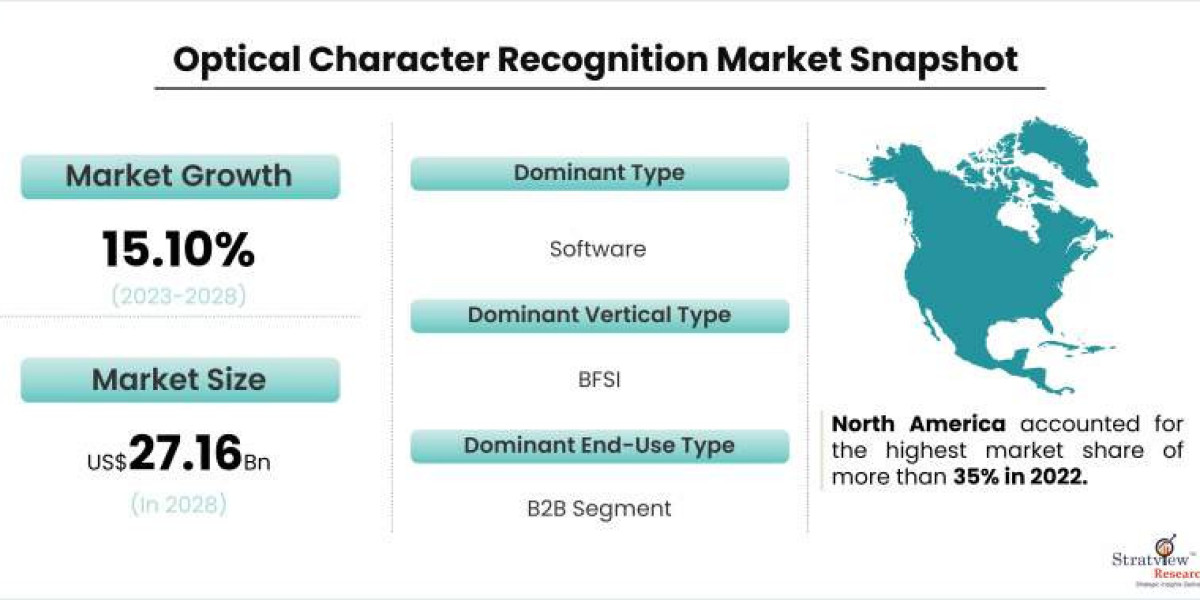The Optical Character Recognition (OCR) market has witnessed significant growth over the past decade, driven by advancements in machine learning and artificial intelligence technologies. OCR, which involves the electronic conversion of images of typed, handwritten, or printed text into machine-encoded text, has become integral across various sectors, including banking, healthcare, retail, and government.
"The optical character recognition market is estimated to grow from USD 11.65 billion in 2022 to USD 27.16 billion by 2028 at a CAGR of 15.10% during the forecast period".
Market Trends
AI and Machine Learning Integration: The integration of AI and machine learning algorithms has vastly improved the accuracy and efficiency of OCR systems. Modern OCR solutions can now handle a variety of fonts and languages, including complex scripts and handwritten text, with high precision.
Cloud-Based OCR Solutions: The shift towards cloud computing has facilitated the development of cloud-based OCR solutions. These solutions offer scalability, remote accessibility, and reduced costs, making them attractive to businesses of all sizes.
Mobile OCR Applications: The proliferation of smartphones has led to the development of mobile OCR applications, enabling users to perform OCR tasks on-the-go. This has been particularly beneficial for sectors like retail and banking, where real-time data extraction is crucial.
Industry-Specific OCR Solutions: There is a growing trend towards industry-specific OCR solutions. For instance, in healthcare, OCR is used to digitize patient records and streamline data entry processes. In banking, OCR facilitates automated check processing and KYC (Know Your Customer) compliance.
Growth Drivers
Digital Transformation Initiatives: As organizations across various sectors embark on digital transformation journeys, the demand for OCR technology has surged. OCR plays a critical role in automating data entry, reducing manual errors, and enhancing operational efficiency.
Regulatory Compliance: Stringent regulatory requirements in industries such as finance and healthcare necessitate the use of OCR for accurate and timely data processing. OCR helps organizations comply with regulations by ensuring that data is captured and stored correctly.
Cost Reduction and Efficiency: OCR technology significantly reduces the time and cost associated with manual data entry. By automating document processing, organizations can redirect resources to more strategic activities, thereby improving overall productivity.
Rise in Big Data Analytics: The growing emphasis on big data analytics has fueled the demand for OCR. By converting unstructured data into structured formats, OCR enables organizations to harness valuable insights from vast amounts of data.
Future Prospects
The future of the OCR market looks promising, with several emerging trends poised to drive further growth:
Advancements in Natural Language Processing (NLP): As NLP technologies evolve, OCR systems will become even more proficient in understanding context and extracting meaningful information from text. This will enhance the accuracy and usability of OCR solutions.
Expansion into New Languages and Scripts: OCR technology is expected to expand its capabilities to include more languages and scripts, catering to a global user base. This will open up new markets and applications for OCR providers.
Integration with Robotic Process Automation (RPA): The integration of OCR with RPA is set to revolutionize business processes. OCR can feed data into RPA systems, enabling end-to-end automation of complex workflows.
Improved Handwriting Recognition: Continued advancements in deep learning algorithms will improve the accuracy of handwriting recognition, making OCR more effective for applications involving handwritten documents.
Conclusion
The OCR market is on an upward trajectory, driven by technological advancements and the increasing need for efficient data processing solutions. As businesses continue to seek ways to enhance productivity and comply with regulatory standards, the adoption of OCR technology is expected to rise. With ongoing innovations and expanding capabilities, OCR will remain a critical tool in the digital transformation toolkit, offering substantial benefits across various industries.
To read in detail about the market dynamics, Register Here: https://www.stratviewresearch.com/Request-Sample/2716/optical-character-recognition-market.html#form



